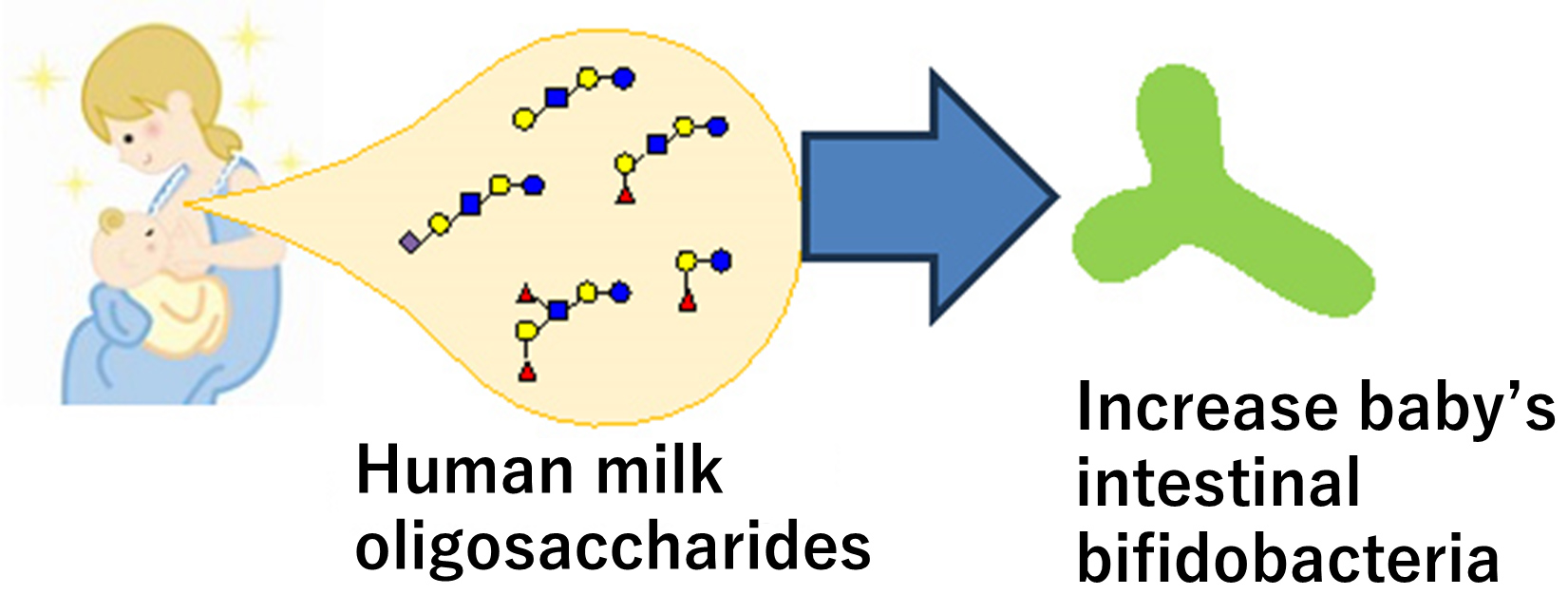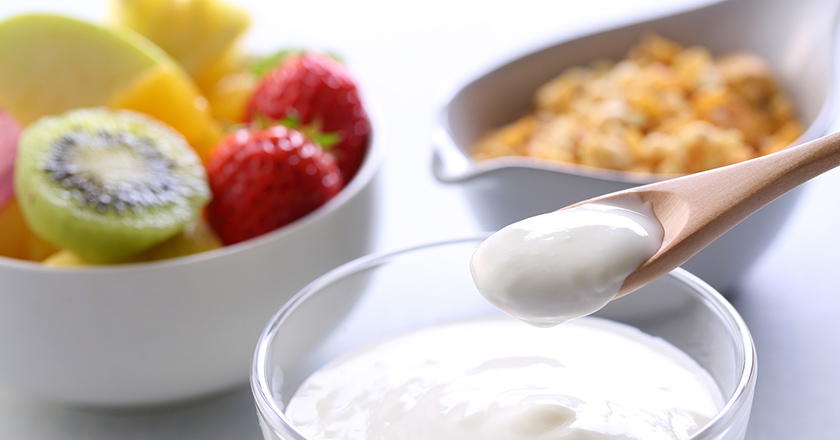The effect of oligosaccharides contained in human breast milk
It is already known that intestinal bacteria contribute to human health. However, their types differ by individuals, and even the same person’s intestinal bacterial flora (intestinal flora) changes with age. For example, bifidobacteria, which are famous as one of the beneficial bacteria, live mainly in the large bowel. However, their number peaks at the babyhood stage and decreases as people age, becoming very low in old age.
Therefore, fermented foods and probiotic products, which allow us to take live bacteria from outside our body, have become noteworthy. In fact, it is said that microbes in ingested fermented food generally will not stay in the intestine. However, as they function to stimulate the immunity of the intestinal tract, I think it is meaningful to take in microbes from food.
While probiotics refer to beneficial microbes for humans, such as bifidobacteria, or the intake of them, the components which propagate or activate beneficial microbes already existing in the intestine are called prebiotics.
Oligosaccharides are known as a major type of these prebiotics. In the Laboratory of Fermented Foods at Meiji University, we conduct research to investigate what kind of intestinal bacteria will be increased by oligosaccharides contained in fermented foods.
Most of the nutritional value in fermented foods is absorbed in the stomach or small bowel. However, non-digestible oligosaccharide and dietary fiber reach the intestine and act as the food for intestinal bacteria. We often hear that oligosaccharides condition our insides. This is because they increase bifidobacteria and keep the intestinal flora in shape.
There are various types of oligosaccharides. I think that perhaps oligosaccharides, which have the intestinal regulation effect, differ from person to person, just like each individual has different intestinal flora.
For example, oligosaccharides in human breast milk increase the bifidobacteria in the intestine of infants and protect them from infectious diseases. Such oligosaccharides are called human milk oligosaccharides, and unique to human breast milk, having a different composition from those of other mammals.
In addition to preventing infectious diseases, human milk oligosaccharides have very important functions for babies, such as entering the blood to improve brain functions. There are more than 200 types of human milk oligosaccharides. They are not yet added to baby formula in Japan, although many companies are making efforts. Aiming for the productization of baby formula with the same component as human breast milk, we researchers are working hard on the research.
However, to avoid misunderstanding, I would like to make it clear that I do not agree with the opinion that babies should be breastfed. I am a mother of two children myself, and raised them by combination with breast milk and formula. While it is a fact that breast milk contains beneficial oligosaccharides, we also see in society some theories praising breastfeeding without any scientific evidence.
In the first place, breastfeeding is physically burdensome for a mother’s body after delivering a child. Sometimes mothers have difficulty producing enough breast milk, depending on their physical condition or how many times they has given birth, etc. There is also the risk of problems such as breast inflammation. Moreover, there may be a difficult situation such as struggling to juggle work with childcare. Under such situations, if people around a mother push her to breastfeed her child, it will be very mentally burdensome for her.
That is why I think that if the research on the mechanism of intestinal bacteria advances, and a baby formula which contains human milk oligosaccharides is productized and spreads, it will help alleviate the burden on mothers’ bodies and make it easier for mothers with difficulty breastfeeding and their partner and babysitter to feed babies.
Genes of the degrading enzyme that bifidobacteria possess
It has been found that a sugar called lacto-N-biose I (LNB), the core component of human milk oligosaccharides, is a growth factor for bifidobacteria.
Human milk oligosaccharides in breast milk do not directly serve as nutrition for a baby but are carried to the intestine. In the intestinal tract, bifidobacterias, which specifically possess enzymes capable of degrading human milk oligosaccharides, metabolize them and it is the enzyme called lacto-N-biosidase (LNBase) that cleaves LNB from the human milk oligosaccharides.
In the joint research so far, the reaction mechanism based on the structural information of the enzyme has been clarified. Incidentally, just by slightly modifying the conformation of the amino acids contained in the enzyme, a chemical reaction to decompose oligosaccharides can be changed to a chemical reaction to synthesize them. Just to be clear, in the case of a synthesizing reaction, we change the material to proceed with the synthetic chemical reaction. Currently we are working on this research to change the function of the enzyme.
Moreover, by discovering the amino acid residue that is important for the reaction, it was suggested that human intestinal bacteria besides bifidobacteria also possess LNBase activity. As previously mentioned, intestinal bifidobacteria are most dominant during infancy, and some bacteria of the intestinal flora will be replaced during the weaning period and shift to the intestinal environment of a mature adult. As a result of recent studies, we have discovered that during the weaning period, intestinal bacteria other than bifidobacteria have the function of using human milk oligosaccharides.
It is considered that those intestinal bacteria produce butyric acid in the intestine and contribute to human health. Intestinal bacteria of adults do not change unless something significant happens, such as the intake of lots of antibiotics or colon cleansing. Therefore, in order to gain better intestinal flora, the weaning period is thought to be important.
Also for the adult body, bifidobacteria create short-chain fatty acids such as acetic acids, nourishing intestinal tracts and helping to prevent infections. In the future I hope that oligosaccharides contained in breast milk can increase bifidobacteria in the intestine of adults and older people as well as babies, and It is expected that such research will also become more active.
Furthermore, when the genetic information was explored, it was found that in fact the bifidobacteria in the intestine of other mammals also have the same gene as that of the bifidobacteria from babies that make use of human milk oligosaccharides. This is an interesting discovery from the perspective of evolution.
For example, chimpanzees are said to have the closest genome to humans among existing animals. However, when their breast milk components are compared, they are not similar, and the composition of contained oligosaccharides is also completely different. In fact, from the bifidobacteria in the intestine of chimpanzees, the enzyme to decompose human milk oligosaccharides has not yet been discovered. Within the genome of bifidobacteria derived from gorillas, which is close to humans in terms of genetic information, a similar gene as LNBase has not been found so far.
However, a type of monkey called the red-handed tamarin living in part of South America, has a gene that is presumed to be LNBase within the genome of bifidobacteria in the intestine. Why do they have such a gene while it is supposed that both the breast milk components and the oligosaccharide composition are different? In the future, I hope to clarify the significance of having LNBase gene from the aspect of mammals’ evolution.

Tips to getting healthy with fermented foods
As you can see, interest in the chemical nature and genetic information of intestinal bacteria is endless. On the other hand, fermented foods with such intestinal bacteria are also something very familiar that you are eating on a daily basis. In my laboratory, I would also like to focus on the research on the health effects of fermented foods.
There are various types of fermented foods. Perhaps many people associate fermentation with increased nutritional value. I think some may take up fermented foods touting it as highly functional, hoping for effects such as preventing memory loss, improving high blood pressure, and reducing fat.
Indeed, fermented foods have been eaten since old times to increase nutritional value. For example, instead of eating unfermented soy beans, eating fermented ones like natto and miso is very beneficial in the sense that they contain microbes and various nutritious substances such as vitamins.
From the perspective of intestinal bacteria, I think it is important to consider whether the fermented food tastes good and matches people’s preference, as well as its functionality. Because in order to see the effects, continuous and sufficient amount of intake is necessary.
Since we can expect the effects of probiotics by taking them on a daily basis, I think it is important to consider whether they are tasty, whether they are easy for children and aged people to eat, etc.
By the way, while it is said that we should reduce our salt intake for our health because too much salt intake will cause high blood pressure, most fermented foods such as soy sauce, miso, and pickles contain salt.
However, salt is important because it prevents other putrid bacteria and lets other microbes that will not die with salt safely advance their fermentation. It is essential to prolong the maturation period to create substances to make things tastier after fermentation.
Therefore, personally, I think it is better to reduce the final amount of salt intake from fermented foods rather than reducing salt during the production process. For example, in the case of pickles, if we rinse them with water before eating, we can reduce the salt level to some extent, without reducing salt during the production process. Moreover, adding acidity using vinegar, etc. boosts salty taste even with less salt used, thus enabling the reduction of soy sauce intake.
These days, we are also conducting the research on pot-made black vinegar that is traditionally produced in Fukuyama City in Kagoshima Prefecture. Normal vinegar is created through saccharification by koji (malted rice), alcoholic fermentation by enzyme, and acetic fermentation by acetic bacteria. To create pot-made black vinegar, lactic bacteria are used in addition to all of the above.
It is considered that the beneficial functional substance in it is created by the lactic acid. Lactic acid not only increases preservability, but also nutritional value by creating various substances. Since its bacterial cell component is said to have immunoregulatory activity, it is thought to be good for our health if we take tablets of moromi mash, which is removed by filtrations.
Through the research on fermented foods, oligosaccharides, intestinal bacteria, and genes, I am hoping to contribute to people’s health and the reduction of their burdens.
* The information contained herein is current as of June 2024.
* The contents of articles on Meiji.net are based on the personal ideas and opinions of the author and do not indicate the official opinion of Meiji University.
* I work to achieve SDGs related to the educational and research themes that I am currently engaged in.
Information noted in the articles and videos, such as positions and affiliations, are current at the time of production.

